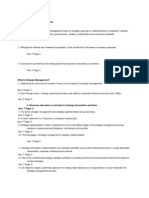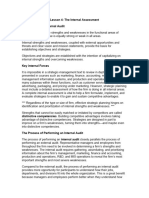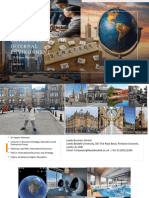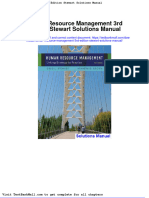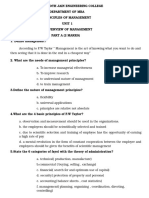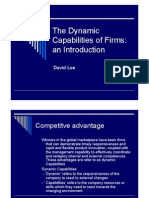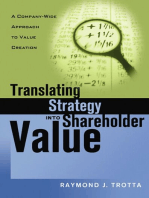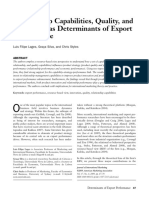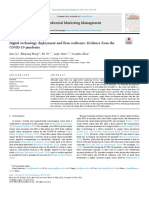David Tif 04
David Tif 04
Uploaded by
aslanozbay33Copyright
Available Formats
Share this document
Did you find this document useful?
Is this content inappropriate?
Report this DocumentCopyright:
Available Formats
David Tif 04
David Tif 04
Uploaded by
aslanozbay33Copyright:
Available Formats
Chapter 4: The Internal Assessment
CHAPTER 4
The Internal Assessment
True/False
The Nature of an Internal Audit
1. Opportunities are a firm’s distinctive competencies that cannot be easily matched or
imitated by competitors.
(f; easy; p. 105)
2. The process of performing an internal audit, compared to the external audit, provides
more opportunity for participants to understand how their jobs, departments and
divisions fit into the whole organization.
(t; medium; p. 105; AACSB: Reflective thinking skills)
3. An internal audit task force of managers could be charged with determining a
specific number (usually 10 to 20) of the most important strengths and weaknesses.
(t; medium; p. 105)
The Resource-Based View
4. Proponents of the resource-based view argue that external factors are more
important than internal factors for a firm in achieving and sustaining competitive
advantage
(f; difficult; p. 106; AACSB: Reflective thinking skills)
5. The basic premise of the research-based view is that the mix, type, amount and
nature of a firm’s internal resources should be considered first and foremost in
devising strategies that can lead to sustainable competitive advantage.
(f; medium; p. 107)
Integrating Strategy and Culture
6. The subtle, elusive and largely unconscious forces that shape the workplace are
captured by the organizational culture.
(t; medium; p. 107)
337
Copyright © 2009 Pearson Education, Inc. Publishing as Prentice Hall
Chapter 4: The Internal Assessment
7. Cultural products include values, beliefs, stories, and language.
(t; easy; p. 108)
8. Metaphors are handed-down narratives of some wonderful event that is based on
history but has been embellished with fictional detail.
(f; medium; p. 108)
9. A ritual is a standardized, detailed set of techniques and behaviors that manage
anxieties but seldom produce intended, technical consequences of practical
importance.
(t; easy; p. 108)
10. In China, business behaviors revolve around guanxi, or personal relations.
(t; medium; p. 109; AACSB: Multicultural and diversity understanding)
11. Linkages between a firm’s culture and strategies often determine success.
(t; easy; p. 109)
12. The U.S. understanding of Far Eastern cultures is a strength its firms have in
competing with Pacific Rim firms.
(f; medium; p. 109; AACSB: Multicultural and diversity understanding)
13. In China, to show that you enjoyed your meal, you should completely finish your
food.
(f; medium; p. 110; AACSB: Multicultural and diversity understanding)
14. The smile is one form of communication that works the same worldwide.
(t; easy; p. 110; AACSB: Multicultural and diversity understanding)
15. In the U.S., personal achievement and accomplishments are more important than
time spent with the family and the quality of relationships espoused by some
cultures.
(t; medium; p. 110; AACSB: Multicultural and diversity understanding)
16. Punctuality, in general, is revered in all cultures of the world.
(f; easy; p. 110; AACSB: Multicultural and diversity understanding)
338
Copyright © 2009 Pearson Education, Inc. Publishing as Prentice Hall
Chapter 4: The Internal Assessment
17. In the United States, an amicable relationship is often mandatory before conducting
business.
(f; medium; p. 110; AACSB: Multicultural and diversity understanding)
Management
18. Allocating resources is one of the five basic activities (functions) performed by
managers.
(f; medium; p. 111)
19. The only certain thing about the future of any organization is change.
(t; medium; p. 105; AACSB: Reflective thinking skills)
20. Organizing is the cornerstone of effective strategy formulation.
(f; easy; p. 111)
21. Planning should be performed mostly by middle management and then presented to
top management for analysis and approval.
(f; medium; p. 112)
22. Controlling is the management function that is most important for the evaluation
stage of the strategic management process.
(t; medium; p. 112)
23. The purpose of organizing is to achieve coordinated effort by defining task and
authority relations.
(t; medium; p. 113)
24. Motivation is one explanation why some people work hard and others do not.
(t; easy; p. 105)
25. The management function of organizing is included in human resource management.
(f; medium; p. 114)
26. The controlling function of management is synonymous to strategy formulation.
(f; medium; p. 115)
339
Copyright © 2009 Pearson Education, Inc. Publishing as Prentice Hall
Chapter 4: The Internal Assessment
Marketing
27. There are seven basic functions of marketing: customer analysis, selling, product
and service planning, pricing, distribution, marketing research and opportunity
analysis.
(t; medium; p. 116)
28. A form of customer analysis is administering customer surveys.
(f; medium; p. 105; AACSB: Reflective thinking skills)
29. Successful strategy formulation generally rests upon the ability of an organization to
sell some product or service.
(f; medium; p. 116)
30. A new trend is to base advertising rates solely on sales rates with regard to
advertising products or services on the Internet.
(f; medium; p. 105)
31. During the 2007 Super Bowl, a 30-second advertisement cost over $2.5 million.
(t; easy; p. 116)
32. GM spends more on advertising than any other firm in the U.S.
(f; medium; p. 116)
33. Newspaper advertising increased by 2.4 percent in 2006.
(f; medium; p. 116)
34. Test marketing is used more frequently by industrial companies than consumer
goods companies.
(f; medium; p. 117)
35. Five major stakeholders that affect pricing decisions are consumers, governments,
suppliers, distributors and competitors.
(t; medium; p. 117)
340
Copyright © 2009 Pearson Education, Inc. Publishing as Prentice Hall
Chapter 4: The Internal Assessment
36. Distribution involves warehousing, marketing research, distribution channels,
wholesaling and retailing.
(f; medium; p. 117)
37. Distribution becomes especially important when a firm is striving to implement a
product development or backward integration strategy.
(f; medium; p. 118; AACSB: Reflective thinking skills)
38. Marketing research is the systematic gathering, recording and analyzing of data
about problems relating to the marketing of goods and services.
(t; easy; p. 118)
39. An opportunity analysis is an appraisal of the costs, benefits and risks associated
with marketing decisions.
(t; medium; p. 118)
Finance/Accounting
40. Three areas, according to James Van Horne, comprise the functions or basic
decision areas of finance: the investment decision, the financing decision and the
earnings decision.
(f; medium; p. 119)
41. Financial ratios are not applicable to nonprofit organizations.
(f; medium; p. 119)
42. Dividend decisions concern issues such as the percentage of earnings paid to
stockholders, the stability of dividends paid over time and the repurchase or issuance
of stock.
(t; difficult; p. 120)
43. The idea that paying dividends results in a higher stock price is a myth.
(t; medium; p. 120)
341
Copyright © 2009 Pearson Education, Inc. Publishing as Prentice Hall
Chapter 4: The Internal Assessment
44. The percentage of companies among the S&P 500 that raised their dividends
decreased in 2006.
(t; medium; p. 120)
45. Activity ratios measure how effectively a firm is using its resources.
(t; medium; p. 122; AACSB: Analytic skills)
46. Leverage ratios measure a firm’s ability to meet maturing short-term obligations.
(f; difficult; p. 122; AACSB: Analytic skills)
47. Total assets turnover ratio is calculated by dividing sales by fixed assets.
(f; medium; p. 122; AACSB: Analytic skills)
48. Financial ratio analysis rarely has to go beyond the actual calculation and
interpretation of ratios.
(f; medium; p. 124; AACSB: Analytic skills)
49. A limitation of financial ratios is the fact that they are based on accounting data.
(t; difficult; p. 124; AACSB: Analytic skills)
Production/Operations
50. Capacity decisions concern the design of the physical production system.
(f; easy; p. 126)
51. In most industries, only minor costs of producing a product or service are incurred
within operations, so production/operations does not have great value as a
competitive weapon in a company’s overall strategy.
(f; medium; p. 126)
52. The U.S. has the highest average hourly pay for auto workers
(f; easy; p. 127; AACSB: Multicultural and diversity understanding)
53. Increased efficiency, quality, productivity and job satisfaction can come from cross-
training workers.
(t; medium; p. 127)
342
Copyright © 2009 Pearson Education, Inc. Publishing as Prentice Hall
Chapter 4: The Internal Assessment
Research and Development
54. Four common approaches to determine R&D budget allocations used successfully
are: (1) finance as many project proposals as possible; (2) use a percentage-of-sales
method; (3) budget for R&D about what competitors spend; or (4) decide how many
successful new products are needed and work backwards to estimate the required
R&D investment.
(t; difficult; p. 129)
55. Internal R&D and contract R&D are the two basic forms of R&D in organizations.
(t; easy; p. 129)
56. Spending on research and development is steadily decreasing in the United States.
(f; easy; p. 130; AACSB: Multicultural and diversity understanding)
Management Information Systems
57. The functions of information systems are growing in importance because
organizations are becoming more complex, decentralized and globally dispersed.
(t; medium; p. 130)
Value Chain Analysis (VCA)
58. Value Chain Analysis can enable a firm to better identify its own strengths and
weaknesses especially as compared to competitors’ Value Chain Analyses.
(t; medium; p. 132)
59. Although a useful step in the strategic management process, value chain analysis
can rarely help a firm monitor whether its prices and costs are competitive.
(f; difficult; p. 132)
60. Benchmarking is an analytical tool used to determine whether a firm’s value chain
activities are competitive compared to rivals.
(t; medium; p. 134; AACSB: Analytic skills)
343
Copyright © 2009 Pearson Education, Inc. Publishing as Prentice Hall
Chapter 4: The Internal Assessment
The IFE Matrix
61. Internal Factor Evaluation Matrix is a summary step when conducting an internal
strategic-management audit.
(t; easy; p. 134)
62. The Internal Factor Evaluation Matrix should include from 10 to 20 key factors
(t; easy; p. 135; AACSB: Analytic skills)
Multiple Choice
The Nature of an Internal Audit
63. A firm’s strengths that cannot be easily matched or imitated by competitors are
called
a. internal audits.
b. distinctive competencies.
c. external audits.
d. special properties.
e. internal properties.
(b; easy; p. 105)
64. Who should perform an internal audit?
a. A private auditing firm
b. The organization’s accounting department
c. Managers from different units of the organization
d. A team of top-level managers and lower-level employees
e. The chief executive officer
(c; easy; p. 105)
65. _______ exemplifies the complexity of relationships among the functional areas of
business.
a. Government audit
b. External audit
c. Financial ratio analysis
d. Environmental scanning
e. Distribution strategy
(c; easy; p. 106)
344
Copyright © 2009 Pearson Education, Inc. Publishing as Prentice Hall
Chapter 4: The Internal Assessment
The Resource-Based View
66. The internal resource categories used in the resource-based approach are physical
resources, human resources and
a. financial resources.
b. shareholder resources.
c. organizational resources.
d. natural resources.
e. technological resources.
(c; medium; p. 106)
67. Organizational resources include all of the following except:
a. employee training.
b. firm structure.
c. planning processes.
d. information systems.
e. copyrights.
(a; medium; p. 106)
68. Empirical indicators are resources that are either rare, hard to imitate, or
a. expensive.
b. inexpensive.
c. easily substitutable.
d. not easily substitutable.
e. inefficient.
(d; medium; p. 107)
Integrating Strategy and Culture
69. A pattern of behavior developed by an organization as it learns to cope with its
problems of external adaptation and internal integration that has worked well
enough to be considered valid and to be taught to new members as the correct
way to perceive, think and feel is called
a. dysfunctional behavior.
b. groupthink.
c. behavior modification.
d. organizational culture.
e. internal audit effect.
(d; difficult; p. 105; AACSB: Reflective thinking skills)
345
Copyright © 2009 Pearson Education, Inc. Publishing as Prentice Hall
Chapter 4: The Internal Assessment
70. Which of the following is not a cultural product?
a. Rites
b. Emotions
c. Rituals
d. Sagas
e. Symbols
(b; easy; p. 107)
71. A standardized, detailed set of techniques and behaviors that manage anxieties,
but seldom produce intended, technical consequences of practical results are
called
a. folktales.
b. rites
c. metaphors
d. rituals
e. values
(d; easy; p. 107)
72. What are historical narratives describing the unique accomplishments of a group
and its leaders, usually in heroic terms.
a. rites
b. sagas
c. stories
d. myths
e. folktales
(b; easy; p. 107)
73. Life-directing attitudes that serve as behavioral guidelines are called
a. values.
b. rites.
c. beliefs
d. metaphors
e. legend
(a; easy; p. 107)
346
Copyright © 2009 Pearson Education, Inc. Publishing as Prentice Hall
Chapter 4: The Internal Assessment
74. In Europe, it is generally true that the farther __________ on the continent, the
more participatory the management style.
a. south
b. east
c. west
d. north
e. southeast
(d; medium; p. 109; AACSB: Multicultural and diversity understanding)
75. Americans place an exceptionally high priority on __________ whereas many
foreigners place more worth on __________.
a. time; relationships
b. relationships; time
c. silence; time
d. silence; relationships
e. close personal distance; ample personal distance
(b; medium; p. 110; AACSB: Multicultural and diversity understanding)
Management
76. What is the essential bridge between the present and the future that increases the
likelihood of achieving desired results?
a. Motivating
b. Planning
c. Controlling
d. Staffing
e. Organizing
(b; medium; p. 111)
77. All of the following are basic duties of a manager except:
a. staffing.
b. planning.
c. consolidating.
d. organizing.
e. motivating.
(c; difficult; p. 111)
347
Copyright © 2009 Pearson Education, Inc. Publishing as Prentice Hall
Chapter 4: The Internal Assessment
78. What is an up-front investment in success?
a. Planning
b. Organizing
c. Motivating
d. Staffing
e. Controlling
(a; easy; p. 111)
79. Which function of management includes areas such as job design, job specification,
job analysis and unity of command?
a. planning
b. organizing
c. motivating
d. staffing
e. controlling
(b; medium; p. 113)
80. Who does a planning horizon of two to five years applies to?
a. top management
b. general management
c. middle management
d. lower management
e. all levels of management
(a; medium; p. 112)
81. Synergy is
a. synthetic energy.
b. when a team effort is used to achieve desired results.
c. when individuals work separately to achieve desired results.
d. when financial expectations of the firm are decided upon.
e. employee energy.
(b; easy; p. 113)
82. Which management function includes breaking tasks into jobs, combining jobs to
form departments and delegating authority?
a. motivating
b. staffing
c. organizing
d. controlling
e. planning
(c; difficult; p. 113; AACSB: Reflective thinking skills)
348
Copyright © 2009 Pearson Education, Inc. Publishing as Prentice Hall
Chapter 4: The Internal Assessment
83. Which function of management is concerned with span of control and chain of
command?
a. planning
b. organizing
c. controlling
d. directing
e. evaluating
(b; easy; p. 113)
84. Which of the following is the process of influencing people to accomplish specific
objectives?
a. Staffing
b. Motivating
c. Planning
d. Controlling
e. Organizing
(b; medium; p. 113)
85. _______ is a major component in motivation.
a. Forecasting
b. Organizational structure
c. Recruiting
d. Management development
e. Communication
(e; medium; p. 113)
86. Staffing involves all of these activities except:
a. recruiting.
b. transferring.
c. customer analysis.
d. managing union relations.
e. training and developing.
(c; medium; p. 114)
349
Copyright © 2009 Pearson Education, Inc. Publishing as Prentice Hall
Chapter 4: The Internal Assessment
87. Which function of management includes all of those activities undertaken to ensure
actual operations conform to planned operations?
a. Planning
b. Organizing
c. Motivating
d. Staffing
e. Controlling
(e; medium; p. 115; AACSB: Reflective thinking skills)
88. The first step in the controlling function of management is to
a. take corrective actions.
b. restrict breaks employees take.
c. evaluate expense reports.
d. establish performance standards.
e. measure individual and organizational performance.
(d; medium; p. 115)
89. All of the following are key questions that can reveal internal strengths and
weaknesses in the management department except:
a. Is the organization’s structure appropriate?
b. Are reward and control mechanisms effective?
c. Are the organization’s products positioned well among competing products?
d. Does the firm use strategic management concepts?
e. Do managers delegate authority well?
(c; medium; p. 115)
Marketing
90. Opportunity analysis is one of the basic functions of
a. marketing.
b. management.
c. computer information systems.
d. production/operations.
e. research and development.
(a; medium; p. 116)
350
Copyright © 2009 Pearson Education, Inc. Publishing as Prentice Hall
Chapter 4: The Internal Assessment
91. _______ can reveal the demographic characteristics of an organization’s customers.
a. Customer profiling
b. Test marketing
c. Market development
d. The vision statement
e. Telemarketing
(a; medium; p. 116)
92. ________ is not considered to be a function of marketing.
a. Market segmentation
b. Marketing research
c. Customer analysis
d. Opportunity analysis
e. Distribution
(a; easy; p. 116)
93. Selling includes all of these marketing activities except:
a. advertising.
b. dealer relations.
c. customer analysis.
d. publicity.
e. sales promotion.
(c; medium; p. 116)
94. Which U.S. firm spent the most on advertising in 2006?
a. P&G
b. GM
c. Verizon
d. Ford
e. AT&T
(a; medium; p. 116)
95. What marketing function includes test marketing?
a. selling products/services
b. pricing
c. customer analysis
d. product/service planning
e. distributing
(d; difficult; p. 105)
351
Copyright © 2009 Pearson Education, Inc. Publishing as Prentice Hall
Chapter 4: The Internal Assessment
96. The Robinson-Patman Act affects a company’s
a. pricing methods.
b. trucking methods.
c. cost of products.
d. employee costs.
e. culture.
(a; difficult; p. 117)
97. Distribution includes
a. customer analysis.
b. pricing.
c. warehousing.
d. advertising.
e. test marketing.
(c; easy; p. 118)
Opportunity Analysis
98. Which of the following is not a key question that can reveal internal strengths and
weaknesses of the marketing department?
a. Does the firm have an effective sales organization?
b. Is our product quality good?
c. Are markets segmented effectively?
d. Are the firm’s products and services priced appropriately?
e. Does the firm have good liquidity?
(e; medium; p. 119; AACSB: Analytic skills)
Finance/Accounting
99. Which of these is the allocation and reallocation of capital and resources to projects,
products, assets and divisions of an organization?
a. Investment decision
b. Dividend decisions
c. Financing decisions
d. Restructuring decisions
e. Strategic decision
(a; difficult; p. 119)
352
Copyright © 2009 Pearson Education, Inc. Publishing as Prentice Hall
Chapter 4: The Internal Assessment
100. Which decision concerns determining the best capital structure for the firm and
includes examining various methods by which the firm can raise capital.
a. investment
b. dividends
c. financing
d. capital budgeting
e. implementation
(c; medium; p. 119)
101. What category of ratios measures a firm’s ability to meet maturing short-term
obligations?
a. Profitability
b. Liquidity
c. Leverage
d. Activity
e. Growth
(b; medium; p. 122; AACSB: Analytic skills)
102. What category of ratios includes return on total assets and return on stockholders’
equity?
a. leverage
b. activity
c. profitability
d. growth
e. liquidity
(c; medium; p. 122; AACSB: Analytic skills)
103. What category of ratios measures how effectively a firm can maintain its economic
position in the growth of the economy and industry?
a. profitability
b. liquidity
c. leverage
d. activity
e. growth
(e; medium; p. 123; AACSB: Analytic skills)
353
Copyright © 2009 Pearson Education, Inc. Publishing as Prentice Hall
Chapter 4: The Internal Assessment
104. Which ratio would be considered an activity ratio?
a. debt-to-equity
b. net profit margin
c. average collection period
d. earnings per share
e. current ratio
(c; medium; p. 122; AACSB: Analytic skills)
105. Which ratio is calculated by dividing profit before interest and taxes by total interest
charges?
a. inventory turnover
b. fixed asset turnover
c. total asset turnover
d. debt-to-equity ratio
e. times-interest-earned
(e; difficult; p. 129; AACSB: Analytic skills)
106. The times interest earned ratio would be classified as a(n):
a. activity ratio
b. leverage ratio
c. profitability ratio
d. liquidity ratio
e. growth ratio
(b; easy; p. 122; AACSB: Analytic skills)
Production/Operations
107. According to Roger Schroeder, which of the following is not a basic function of
production management?
a. Capacity
b. Inventory
c. Workforce
d. Transportation
e. Quality
(d; medium; p. 126)
354
Copyright © 2009 Pearson Education, Inc. Publishing as Prentice Hall
Chapter 4: The Internal Assessment
108. _______ management deals with inputs, transformations and outputs that vary
across industries and markets.
a. Marketing
b. Financial
c. Research and Development
d. Production/operations
e. Distribution
(d; medium; p. 126)
109. Which country has the highest average hourly pay for auto workers?
a. U.S.
b. Canada
c. Japan
d. Germany
e. France
(d; medium; p. 127; AACSB: Multicultural and diversity understanding)
110. Where is the largest seaport, in terms of ship container traffic processed annually?
a. Hong Kong
b. Shanghi
c. Singapore
d. Los Angeles
e. New York
(c; difficult; p. 127; AACSB: Multicultural and diversity understanding)
Research and Development
111. ______ has been successful in determining R&D budget allocations.
a. Financing as many project proposals as possible
b. Using the percentage of sales method
c. Budgeting for R&D about what competitors spend
d. Deciding how many successful new products are needed
e. All of the above have been used
(e; medium; p. 129)
355
Copyright © 2009 Pearson Education, Inc. Publishing as Prentice Hall
Chapter 4: The Internal Assessment
Management Information Systems
112. Which of the following ties all business functions together and provides the basis for
all managerial decisions?
a. Management
b. Marketing
c. Information
d. Technology
e. Workforce
(c; medium; p. 130)
113. A management __________ receives raw material from both the external and
internal evaluation of an organization.
a. advisor
b. information system
c. consultant
d. strategic system
e. accountant
(b; easy; p. 130)
114. __________ become(s) __________ only when they are evaluated, filtered,
condensed, analyzed and organized for a specific purpose, problem, individual, or
time.
a. Information; data
b. Information; material
c. Data; information
d. Data; competitive advantages
e. competitive advantages; material
(c; medium; p. 131)
Value Chain Analysis (VCA)
115. The process whereby a firm determines the costs associated with organizational
activities from purchasing raw materials to manufacturing products to marketing
those products is called
a. the resource-based approach.
b. value chain analysis.
c. strategic cost analysis.
d. the internal factor evaluation matrix.
e. cost-benefit analysis.
(b; medium; p. 132)
356
Copyright © 2009 Pearson Education, Inc. Publishing as Prentice Hall
Chapter 4: The Internal Assessment
116. The initial step to implementing value chain analysis is
a. attaching a cost to each discrete activity.
b. establishing costs in terms of time.
c. establishing costs in terms of money.
d. converting the cost data into information by looking for competitive cost
strengths and weaknesses.
e. dividing a firm’s operations into specific activities or business processes.
(e; easy; p. 132)
The IFE Matrix
117. Which of the following is the first step in developing an IFE Matrix?
a. Determining the organization’s structure
b. Summing the weighted scores for each variable
c. Identifying the organization’s strengths and weaknesses
d. Identifying the organization’s functions of business
e. Determining the lead strategist
(c; medium; p. 135)
118. The IFE Matrix should be _____________ in multidivisional firms.
a. constructed for each division
b. all-inclusive
c. constructed only for the major divisions
d. developed before the EFE Matrix
e. revised monthly
(a; medium; p. 135)
357
Copyright © 2009 Pearson Education, Inc. Publishing as Prentice Hall
Chapter 4: The Internal Assessment
Essay Questions
119. Explain the resource-based view and its relation to strategic management.
The resource-based view (RBV) approach to competitive advantage contends that
internal resources are more important than external factors for a firm in achieving
and sustaining competitive advantage, in contrast to the I/O theory. According to
this view, organizational performance is determined by physical resources, human
resources and organizational resources. RBV theory asserts that resources are
actually what help a firm exploit opportunities and neutralize threats. The theory
also asserts that in order to maintain a competitive advantage, a resource must
either be rare, not easily substitutable, or hard to imitate. The RBV has continued
to grow in popularity and continues to seek a better understanding of the
relationship between resources and sustained competitive advantage.
Page: 106-107
120. Identify and give an example of six cultural products.
Student answers will vary. However, they should include and give examples for any
of the following: rites, ceremonial, ritual, myth, saga, legend, story, folktale, symbol,
language, metaphors, values, belief and heroes/heroines. These products are
explained further in Table 4-1 on page 127
Page: 108
121. Identify any five differences when comparing American versus foreign cultures.
The chapter gives 11 differences between U.S. and foreign managers. Please refer to
page 109-111.
Page: 109-111
122. Identify the five basic functions of management, and describe each function.
The five basic functions of management are planning, organizing, motivating,
staffing and controlling. Please refer to Table 4-3 on page 111 in the text for the
descriptions of each function.
Page: 111-115
358
Copyright © 2009 Pearson Education, Inc. Publishing as Prentice Hall
Chapter 4: The Internal Assessment
123. What four basic steps comprise the controlling function of management?
The controlling function of management is particularly important for effective
strategy evaluation. Controlling consists of four basic steps: (1) establishing
performance standards, (2) measuring individual and organizational performance,
(3) comparing actual performance to planned performance standards and (4) taking
corrective actions.
Page: 115
124. There are seven basic functions of marketing. List and define these functions.
The seven basic functions of marketing are (1) customer analysis, (2) selling
products/services, (3) product and service planning, (4) pricing, (5) distribution, (6)
marketing research and (7) opportunity analysis. Students should define each of
these functions.
Page: 116
125. According to James Van Horne, what are the three decisions that comprise the
functions of finance? Describe each function.
The three basic functions of finance, according to James Van Horne, are the
investment decision, the financing decision and the dividend decision. The
investment decision is the allocation and reallocation of capital and resources to
project, products, assets and divisions of an organization. The financing decision
determines the best capital structure for the firms and includes examining various
methods by which the firm can raise capital. Dividend decisions concern issues such
as the percentage of earning paid to stockholders, the stability of dividends paid over
time and the repurchase or issuance of stock.
Page: 119
359
Copyright © 2009 Pearson Education, Inc. Publishing as Prentice Hall
Chapter 4: The Internal Assessment
126. Identify the reasons dividends are sometimes paid out even when funds could be
better reinvested in the business or when the firm has to tap outside sources to pay
the dividends.
Dividends are sometimes paid out even when funds could be better reinvested in the
business or when the firm has to obtain outside sources of capital. The reasons for
these situations are as follows. (1) Paying cash dividends is customary. Failure to do
so could be thought of as a stigma. A dividend change is considered a signal about
the future. (2) Dividends represent a sales point for investment bankers. Some
institutional investors can buy only dividend-paying stocks. (3) Shareholders often
demand dividends, even in companies with great opportunities for reinvesting all
available funds. (4) A myth exists that paying dividends will result in a higher stock
price.
Page: 120
127. Discuss what needs to be completed, besides the calculation and interpretation of
ratios, to complete an effective financial ratio analysis.
The analysis should be conducted on three separate fronts:
1. How has each ratio changed over time? This information provides a means of
evaluating historical trends. It is important to note whether each ratio has been
increasing, decreasing, or nearly constant historically. For example, a 10 percent
profit margin could be bad if the trend has been down 20 percent each of the last
three years. But a 10 percent profit margin could be excellent if the trend has been
up, up, up. Therefore, calculate the percentage change in each ratio from one year
to the next to assess historical financial performance on that dimension. Identify
and examine large percent changes in a financial ratio from one year to the next.
2. How does each ratio compare to industry norms? A firm’s inventory turnover
ratio may appear impressive at first glance, but may pale when compared to
industry standards or norms. Industries can differ dramatically on certain ratios.
For example grocery companies such as Kroger have a high inventory turnover
whereas automobile dealerships have a lower turnover. Therefore, comparison of
a firm’s ratios within its particular industry can be essential in determining
strength/weakness.
3. How does each ratio compare with key competitors? Oftentimes competition is
more intense between several competitors in a given industry or location than
across all rival firms in the industry. When this is true, financial ratio analysis
should include comparison to those key competitors. For example, if a firm’s
profitability ratio is trending up over time and compares favorably to the industry
average, but it is trending down relative to its leading competitor, there may be
reason for concern.
Page: 124
360
Copyright © 2009 Pearson Education, Inc. Publishing as Prentice Hall
Chapter 4: The Internal Assessment
128. Discuss the limitations of financial ratio analysis.
There are some limitations of financial ratio analysis. The first is that financial ratios
are based on accounting data, and firms differ in their treatment of such items as
depreciation, inventory valuation, R&D expenditures, pension plan costs, mergers
and taxes. Second, seasonal factors can influence comparative ratios. A third
limitation is that departures from industry averages do not always indicate a firm is
doing especially well or badly.
Page: 124
129. According to Roger Schroeder, there are five basic functions or decision areas in
production. Describe these five functions.
The five basic functions or decision areas in production are process, capacity,
inventory, workforce and quality. Please refer to Table 4-5 on page 147 in the text
for descriptions of each function or decision area.
Page: 126
130. Four basic approaches exist to determine R&D budget allocations. What are these
approaches? Which one would you recommend for a pharmaceutical company?
Why?
The four approaches to determining commonly used R&D budget allocations are:
(1) financing as many project proposals as possible; (2) using a percentage-of-sales
method; (3) budgeting about the same amount competitors spend for R&D; and (4)
deciding how many successful new products are needed and working backward to
estimate the required R&D investment.
Students should recommend the fourth approach for a pharmaceutical company,
deciding how many successful new products are needed, and work backward to
estimate the required R&D investment, because most firms have no choice but to
continually develop new and improved products because of changing consumer
needs and tastes, new technologies, shortened product life cycles and increased
domestic and foreign competition. Students should also mention that different
strategies require different R&D capabilities, so no one approach will be appropriate
for all companies at all times.
Page: 129
361
Copyright © 2009 Pearson Education, Inc. Publishing as Prentice Hall
Chapter 4: The Internal Assessment
131. Discuss the five steps involved in performing an IFE Matrix.
The first step is to list ten to twenty internal factors, including strengths and
weaknesses using percentages, ratios and comparative numbers. The second step
is to assign a weight that ranges from 0.00 (not important) to 1.0 (all-important) to
each factor based on its relative importance. The third step is to assign a 1 to 4
rating to each factor to indicate whether that factor represents a major weakness, a
minor weakness, a major strength, or a minor strength. Next, multiply each
factor’s weight by its rating to determine a weighted score for each variable.
Finally, sum the weighted scores for each variable to determine the total weighted
score for the organization.
Page: 134-136 \
362
Copyright © 2009 Pearson Education, Inc. Publishing as Prentice Hall
You might also like
- Internal ScanningDocument4 pagesInternal Scanningfikha zahirahNo ratings yet
- David Tif 01Document26 pagesDavid Tif 01aslanozbay33No ratings yet
- SM MCQS David CH4Document14 pagesSM MCQS David CH4zarnab azeemNo ratings yet
- David Tif 09Document23 pagesDavid Tif 09aslanozbay33No ratings yet
- David Tif 03Document24 pagesDavid Tif 03aslanozbay33No ratings yet
- Question and Answer For Chapter 4Document16 pagesQuestion and Answer For Chapter 4Asmerom MosinehNo ratings yet
- David Tif 08Document22 pagesDavid Tif 08aslanozbay33No ratings yet
- CH 06Document15 pagesCH 06Czarina CasallaNo ratings yet
- Strategic MGT Quest N AnsDocument28 pagesStrategic MGT Quest N AnsVICTORIA MUNISINo ratings yet
- Ôn tập cuối kỳ QTCLDocument22 pagesÔn tập cuối kỳ QTCLuyen doNo ratings yet
- The Nature of Strategic ManagementDocument24 pagesThe Nature of Strategic ManagementPaula SalasNo ratings yet
- SM MCQS David CH9Document16 pagesSM MCQS David CH9zarnab azeemNo ratings yet
- Strategy GlossaryDocument15 pagesStrategy GlossaryMahmoud SaeedNo ratings yet
- Chapter 1Document14 pagesChapter 1fffatima100% (1)
- Knowledge Management and Competitive AdvantageDocument8 pagesKnowledge Management and Competitive AdvantageChristianto LukmantoroNo ratings yet
- Competitive Intelligence Lead ToDocument11 pagesCompetitive Intelligence Lead ToHeldi SahputraNo ratings yet
- IISTE November Issue. High Impact FactorDocument8 pagesIISTE November Issue. High Impact Factorjust justNo ratings yet
- CIPD Activity 2.3 Case StudyDocument10 pagesCIPD Activity 2.3 Case Studyvagabondage0511No ratings yet
- MGT7 - Lesson 4 0Document13 pagesMGT7 - Lesson 4 0Puti TaeNo ratings yet
- Managing Global AllianceDocument13 pagesManaging Global AlliancePramod SinghNo ratings yet
- Types of Competitive Advantage and Analysis: ISSN 1833-3850 E-ISSN 1833-8119Document5 pagesTypes of Competitive Advantage and Analysis: ISSN 1833-3850 E-ISSN 1833-8119Thabo KholoaneNo ratings yet
- Chapter01 Questions and AnswersDocument28 pagesChapter01 Questions and AnswersOrville Munroe100% (1)
- Academic Tweetcast - Resource-Based Theory of Competitive Advantage: Implications For Strategy FormulationDocument7 pagesAcademic Tweetcast - Resource-Based Theory of Competitive Advantage: Implications For Strategy FormulationsaidhamidehNo ratings yet
- Planning Organizing Leading Staffing Controlling: Key Terms in Strategic Management 1. ManagementDocument9 pagesPlanning Organizing Leading Staffing Controlling: Key Terms in Strategic Management 1. ManagementRose Ann GarciaNo ratings yet
- Group 1 - OeshrmDocument24 pagesGroup 1 - OeshrmDonna O. O'Connor0% (1)
- Human Aspect Issues After Mergers and AcquisitionsDocument4 pagesHuman Aspect Issues After Mergers and AcquisitionsA B100% (1)
- Steps Involved in The Development of IFE MatrixDocument9 pagesSteps Involved in The Development of IFE MatrixFarrukh MinhasNo ratings yet
- QuizDocument28 pagesQuizQuỳnh QuỳnhNo ratings yet
- 2024 GBS Week 4 LecturerDocument38 pages2024 GBS Week 4 LecturerAyesha IrumNo ratings yet
- Sem 1 Strategic MGMT Sol 2019Document4 pagesSem 1 Strategic MGMT Sol 2019Vedant RaneNo ratings yet
- SM MCQS David CH1Document14 pagesSM MCQS David CH1zarnab azeemNo ratings yet
- 3010 Strategic ManagementDocument12 pages3010 Strategic ManagementRedoy HossainNo ratings yet
- S & EPM Unit 1 PPT 1-3Document85 pagesS & EPM Unit 1 PPT 1-3SaikatPatraNo ratings yet
- Ch4 Attributes of Strategic ResourcesDocument21 pagesCh4 Attributes of Strategic ResourcesSyazlynAmynuddynNo ratings yet
- MGT603 - Strategic Management Solved Subjective For Midterm Exam Preparation Spring 2013Document18 pagesMGT603 - Strategic Management Solved Subjective For Midterm Exam Preparation Spring 2013Haider Ehsaan MalikNo ratings yet
- Essay QuestionsDocument12 pagesEssay QuestionsMai El RihanyNo ratings yet
- MB609 Capstone Strategic ManagementDocument16 pagesMB609 Capstone Strategic ManagementG JhaNo ratings yet
- Fom5 Tif05Document30 pagesFom5 Tif05GeorgeAru100% (1)
- Chapter 3-SolutionsDocument2 pagesChapter 3-SolutionsArtika DeviNo ratings yet
- Literature ReviewDocument3 pagesLiterature ReviewmahedNo ratings yet
- Ch.4 HRM Strategies For Competitive AdvantageDocument45 pagesCh.4 HRM Strategies For Competitive AdvantagePranav PanchalNo ratings yet
- Chapter 5 Internal Scanning and Organizational Analysis: Strategic Management & Business Policy, 14e (Wheelen)Document18 pagesChapter 5 Internal Scanning and Organizational Analysis: Strategic Management & Business Policy, 14e (Wheelen)aafnanNo ratings yet
- Strategy Concept and Process: Chapter-2Document4 pagesStrategy Concept and Process: Chapter-2tariqNo ratings yet
- The Effect of Negotiation On Sales Performance in An OrganisationDocument10 pagesThe Effect of Negotiation On Sales Performance in An OrganisationSNo ratings yet
- Tài Liệu CLTC FinalDocument10 pagesTài Liệu CLTC FinalN Ngoc AnhNo ratings yet
- PARTS AnalysisDocument6 pagesPARTS AnalysisAshish BhakuniNo ratings yet
- Strategic Competitiveness: Above-Average Returns Risk Average Returns Strategic Management ProcessDocument2 pagesStrategic Competitiveness: Above-Average Returns Risk Average Returns Strategic Management ProcessAlexNo ratings yet
- Building A Capable Organization: The Eight Levers of Strategy ImplementationDocument9 pagesBuilding A Capable Organization: The Eight Levers of Strategy ImplementationMukund KabraNo ratings yet
- Strategy ExeDocument40 pagesStrategy Exeshi shiiisshhNo ratings yet
- Human Resource Management 3rd Edition Stewart Solutions ManualDocument36 pagesHuman Resource Management 3rd Edition Stewart Solutions Manualmeow.switchel.2kjze7100% (41)
- Full Download Human Resource Management 3rd Edition Stewart Solutions Manual PDF Full ChapterDocument36 pagesFull Download Human Resource Management 3rd Edition Stewart Solutions Manual PDF Full Chaptertruismborrow6004it100% (24)
- Kale2002 Alliance CapabilityDocument21 pagesKale2002 Alliance CapabilityJean KarmelNo ratings yet
- Pom 2 and 16 MarksDocument65 pagesPom 2 and 16 MarksRam Vasu0% (1)
- BSP Short Questions From First Five ChaptersDocument4 pagesBSP Short Questions From First Five ChaptersKashfmmNo ratings yet
- Identification of Resources That Influence Firm's FormationDocument5 pagesIdentification of Resources That Influence Firm's FormationWaqas AnsariNo ratings yet
- Strategy in Global Context: Session 1Document17 pagesStrategy in Global Context: Session 1Louis-Kevin EtchiNo ratings yet
- The Dynamic Capabilities of Firms: An Introduction: David LeeDocument26 pagesThe Dynamic Capabilities of Firms: An Introduction: David LeeingmkhNo ratings yet
- Translating Strategy into Shareholder Value: A Company-Wide Approach to Value CreationFrom EverandTranslating Strategy into Shareholder Value: A Company-Wide Approach to Value CreationNo ratings yet
- The Learning Advantage: Blending Technology, Strategy, and Learning to Create Lasting ResultsFrom EverandThe Learning Advantage: Blending Technology, Strategy, and Learning to Create Lasting ResultsNo ratings yet
- International Market Entry Strategies of Digital Platform BusinessesDocument75 pagesInternational Market Entry Strategies of Digital Platform BusinessesMikkel SchrøderNo ratings yet
- Conference Paper Abstracts: International ManagementDocument91 pagesConference Paper Abstracts: International ManagementYet Barreda BasbasNo ratings yet
- Green Human Resource Management Practices andDocument10 pagesGreen Human Resource Management Practices andNoha MorsyNo ratings yet
- Small Business Strategies (English)Document40 pagesSmall Business Strategies (English)Nova EkayantiNo ratings yet
- SSRN Id3192207Document22 pagesSSRN Id3192207DivaNo ratings yet
- A Study On Competitive Strategy and Vegetarian Restaurants' Performance in Indonesia: Mediation Impact of Customer LoyaltyDocument21 pagesA Study On Competitive Strategy and Vegetarian Restaurants' Performance in Indonesia: Mediation Impact of Customer Loyaltybornok situmorangNo ratings yet
- Work Readiness Integrated Competence Model Conceptualisation and ScaleDocument23 pagesWork Readiness Integrated Competence Model Conceptualisation and ScaleMelly NadiaNo ratings yet
- 422 1140 1 PBDocument7 pages422 1140 1 PBMbalaNo ratings yet
- Linking Knowledge Management, Organizational Learning and MemoryDocument10 pagesLinking Knowledge Management, Organizational Learning and MemoryGabrielaNo ratings yet
- SHELLDocument15 pagesSHELLAhmed YusufNo ratings yet
- Human Capital and Firm PerformanceDocument44 pagesHuman Capital and Firm PerformanceMuhammad MuaviaNo ratings yet
- The Effects of Marketing Strategies On Sales Performance of Commercial Business in KenyaDocument93 pagesThe Effects of Marketing Strategies On Sales Performance of Commercial Business in KenyaabdulazizNo ratings yet
- JIM Lages Silva Styles 2009Document24 pagesJIM Lages Silva Styles 2009beriNo ratings yet
- Digital Technology Deployment and Firm Resilience E - 2022 - Industrial MarketiDocument10 pagesDigital Technology Deployment and Firm Resilience E - 2022 - Industrial MarketiMisael Diaz HernandezNo ratings yet
- Strategic Staffing PDFDocument21 pagesStrategic Staffing PDFzahedul alamNo ratings yet
- Cost Management and Corporate Performance in Quoted Manufacturing Companies in NigeriaDocument7 pagesCost Management and Corporate Performance in Quoted Manufacturing Companies in NigeriaThe IjbmtNo ratings yet
- Effects of Transformational Leadership, Organisational Learning and Technological Innovation On Strategic Management Accounting in Thailand's Financial InstitutionsDocument24 pagesEffects of Transformational Leadership, Organisational Learning and Technological Innovation On Strategic Management Accounting in Thailand's Financial InstitutionsdiahNo ratings yet
- Resource Based View (RBV) of Competitive Advantage - An OverviewDocument21 pagesResource Based View (RBV) of Competitive Advantage - An Overviewsohaiblatif31100% (1)
- An Evaluation of The Market Entry Strategies Adopted by McdonaldDocument9 pagesAn Evaluation of The Market Entry Strategies Adopted by McdonaldSai Kishore NelloreNo ratings yet
- MM-Syllabus of Strategic Management-2021Document6 pagesMM-Syllabus of Strategic Management-2021Tiffani AnnisaNo ratings yet
- GTL4Document13 pagesGTL4Mushtaq HussainNo ratings yet
- KWL HomeworkDocument2 pagesKWL HomeworkPatricia SantosNo ratings yet
- Unit 2 - Part 2 - Strategic AnalysisDocument35 pagesUnit 2 - Part 2 - Strategic AnalysisSai Ram PasupuletiNo ratings yet
- Family Business ResearchDocument5 pagesFamily Business ResearchZean Carlo SorrondaNo ratings yet
- Media EconomicsDocument18 pagesMedia EconomicsMariana SantivanezNo ratings yet
- Resources and Capabilities: Their Importance How To Analyse ThemDocument34 pagesResources and Capabilities: Their Importance How To Analyse Themvishal7debnat-402755No ratings yet
- The Extent To Which The Creation, Sharing, and Utilization of Knowledge Is Central To The Resource Based View of Competitive AdvantageDocument15 pagesThe Extent To Which The Creation, Sharing, and Utilization of Knowledge Is Central To The Resource Based View of Competitive AdvantageNelix ComNo ratings yet
- Peter Buckley 40 Years of Internationalisation Theory and The MNEDocument20 pagesPeter Buckley 40 Years of Internationalisation Theory and The MNEMadalina CondeiNo ratings yet
- JOM 2016 Impact of Social Media On Operacional EfficiencyDocument16 pagesJOM 2016 Impact of Social Media On Operacional EfficiencyJoana CatarinaNo ratings yet
- MN2615 T1 Session 1 - Entrepreneurship in Economic DevelopmentDocument65 pagesMN2615 T1 Session 1 - Entrepreneurship in Economic DevelopmentHaseeb DarNo ratings yet













